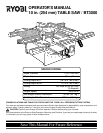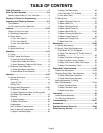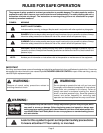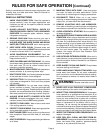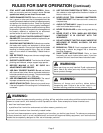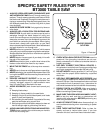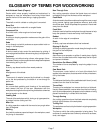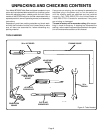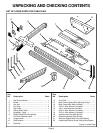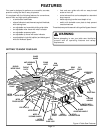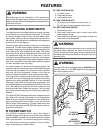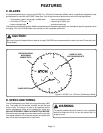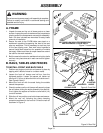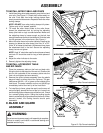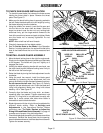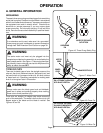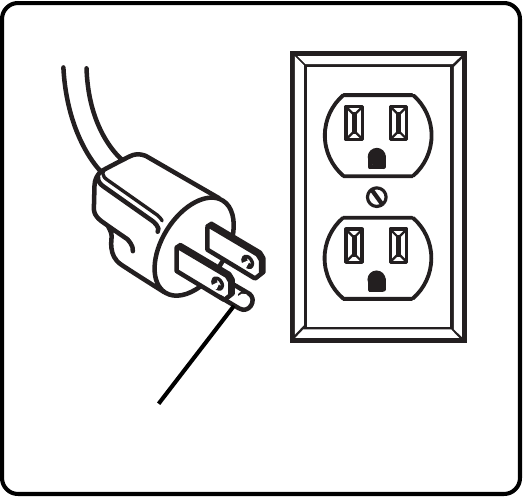
Page 6
1. ALWAYS USE BLADE GUARD, RIVING KNIFE, AND
ANTI-KICKBACK PAWLS on all "through-sawing" op-
erations. Through-sawing operations are those in which
the blade cuts completely through the workpiece as in
ripping or crosscutting. Keep the blade guard down, the
anti-kickback pawls down, and the riving knife in place
over the blade.
2. ALWAYS SECURE WORK firmly against rip fence or
miter fence.
3. ALWAYS USE A PUSH STICK FOR RIPPING NAR-
ROW STOCK. A push stick is a device used to push a
workpiece through the blade instead of using your
hands. Size and shape can vary but the push stick must
always be narrower than the workpiece to prevent the
push stick from contacting the saw blade. When ripping
narrow stock, always use a push stick, so your hand
does not come close to the saw blade. Use a featherboard
and push blocks for non-through cuts.
4. NEVER perform any operation "freehand" which means
using only your hands to support or guide the workpiece.
Always use either the rip fence or miter fence to position
and guide the work.
5. NEVER stand or have any part of your body in line with
the path of the saw blade.
6. NEVER reach behind, over, or within three inches of the
blade or cutter with either hand for any reason.
7. MOVE THE RIP FENCE out of the way when crosscut-
ting.
8. NEVER use rip fence as cutoff gage when crosscutting.
9. NEVER attempt to free a stalled saw blade without first
turning the saw OFF and disconnecting the saw from the
power source.
10. PROVIDE ADEQUATE SUPPORT to the rear and
sides of the saw table for wide or long work pieces. Use
a sturdy "outrigger" support if a table extension more
than 24 inches long is attached to the saw.
11. AVOID KICKBACKS (work thrown back toward you)
by:
A. Keeping blade sharp.
B. Keeping rip fence parallel to the saw blade.
C. Keeping riving knife, anti-kickback pawls, and blade
guard in place and operating.
D. Not releasing the work before it is pushed all the way
past the saw blade using a push stick.
E. Not ripping work that is twisted or warped or does not
have a straight edge to guide along the fence.
12. AVOID AWKWARD OPERATIONS AND HAND POSI-
TIONS where a sudden slip could cause your hand to
move into the cutting tool.
SPECIFIC SAFETY RULES FOR THE
BT3000 TABLE SAW
13. CHECK WITH A QUALIFIED ELECTRICIAN or service
personnel if the grounding instructions are not com-
pletely understood or if in doubt as to whether the tool is
properly grounded.
14. USE ONLY CORRECT ELECTRICAL DEVICES: 3-
wire extension cords that have 3-prong grounding plugs
and 3-pole receptacles that accept the tool's plug.
15. DO NOT MODIFY the plug provided. If it will not fit the
outlet, have the proper outlet installed by a qualified
electrician.
16. USE ONLY RECOMMENDED ACCESSORIES listed
in this manual or addendums. Blades must be rated for
at least 5,500 rpm. Use of accessories that are not listed
may cause the risk of personal injury. Instructions for
safe use of accessories are included with the accessory.
17. DOUBLE CHECK ALL SETUPS. Make sure blade is
tight and not making contact with saw or workpiece
before connecting to power supply.
18. MAKE SURE THE WORK AREA HAS AMPLE LIGHT-
ING to see the work and that no obstructions will
interfere with safe operation BEFORE performing any
work using the table saw.
19. ALWAYS TURN OFF SAW before disconnecting it, to
avoid accidental starting when reconnecting to power
supply.
20. SAVE THESE INSTRUCTIONS. Refer to them fre-
quently and use to instruct other users. If you loan
someone this tool, loan them these instructions also.
Figure 1: Electrical
COVER OF GROUNDED
OUTLET BOX
GROUNDING
PIN



